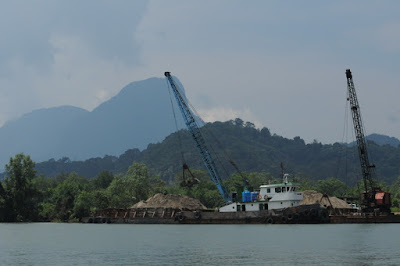On May 13, 2011, Eileen and I, with Eileen's daughter Fiona, her husband Kevin, and our grandson Ryan (who has already appeared in these postings, and will again), pushed off from Damai into the China Sea, en route to the double estuary of the Santubong and Salak Rivers. Kevin and Fiona, who run the Sarawak River Cruise that sails every evening along the Kuching waterfront, were checking out the possibility of adding coastal boat trips to their offerings (for a number of reasons, they decided against it). The rest of us were out for the pure pleasure of a boat ride, and a hunt for a major wildlife-watching goal in western Sarawak: the Irrawaddy Dolphin (Orcaella brevirostris).
We'll come to the dolphins later. For now,though, we are off to sea!
As the boat pulls away from shore, we could look back towards the mass of Santubong Mountain - supposedly, according to Iban legend, the remains of a beautiful princess who angered her father and was turned to stone. You can read the whole story here.
We were not alone on the water. Tiny fishing boats dotted the estuary, looking for catches to sell in the local markets.
We approached one boat as the fishermen were drawing in their nets. They were quite happy to show us their catch.
Small juvenile sharks are frequently caught in the estuary; it may not be possible to tell, from a photograph, exactly which species this is. Tiny sharks are common in markets in many tropical countries; because of the way many sharks excrete, urea can become concentrated in their tissues as they age, giving their flesh a strong taste of ammonia. Very young sharks, like this one, are pretty much ammonia-free (thanks to my friend Susie Watts for this bit of information).
Cutlassfishes are highly prized, though a bit forbidding-looking to a westerner. There two very similar species in Sarawak waters, the Savalani Hairtail (Lepturacanthus savala) and the Largeheaded Hairtail (Trichiurus lepturus). This is, presumably, a young individual of one or the other.
Many of the fishermen in the estuary, however, were after quite different prey. At this time of year, large white jellyfish are abundant in the area - fodder for a trade in their dried flesh, a delicacy among the Chinese. The jellyfish-hunters have their own tools of the trade - not nets, but long boat-hooks.
The hooks draw the gaffed jellyfish within reach for the next stage of the process.
Here is one of the jellyfish - probably Lobonema smithii. If you are not a jellyfish-eater you might not think that there is much substance there - jellyfishes are, after all, largely water - but this species has a particularly stiff bell that can be dried to something with the consistency of a gummy worm.
The next step in bringing the catch aboard involves cleaning the tentacles from around the base of the bell, an operation done by hand...
...before the jellyfish is brought over the side.
After watching the jellyfish hunters, our boat headed upstream into the Salak River. This is the territory of the Saltwater Crocodile (Crocodylus porosus). To paraphrase The Mikado, we didn't see any, but they were there all the same. The sign says so.
This is the territory of the otherwise almost inaccessible Kuching Wetlands National Park, a mangrove forest listed under the Ramsar Convention as a wetland of international importance. The palm trees in this photo are Nipa Palm (Nypa fruticans).
A community of Malay fishermen lives on Pulau Salak, a large island near the mouth of the Salak River. Their village has been there for at least a century.
As we sailed by, we watched fishermen folding their nets...
...or setting out on the river with their families.
The Salak estuary is far from pristine. Dredges haul large quantities of sand from the river bed for use in contruction. The effect of dredging on the local marine mammals is not clear, but as the dredges remove sand from the bottom they take with it bottom-living animals that provide the dolphins (and less common species like the Finless Porpoise (Neophocaena phocaenoides)) with food.
Nonetheless, at least for now the dolphins remain, even within sight of the dredges...
...and in my next post, we will give them a closer look.


























Very nice, Mr. Ron!!! We did this cruise two weeks ago. We did see plenty Irawaddy dolphins up close, but somehow many of the details you mention here escaped me. Thanks for filling me in!
ReplyDeleteThank you for the wealth of information and local context in this post! We recently anchored off Pulau Lakei and were entranced (and a little intimidated) by the jellies. It's fascinating to see how they are fished... I sampled a jellyfish dish in Kuching later! If you're interested, I've written a little about it here: http://sv-totem.blogspot.com/2013/08/swimming-in-jellyfish-swarm.html
ReplyDelete